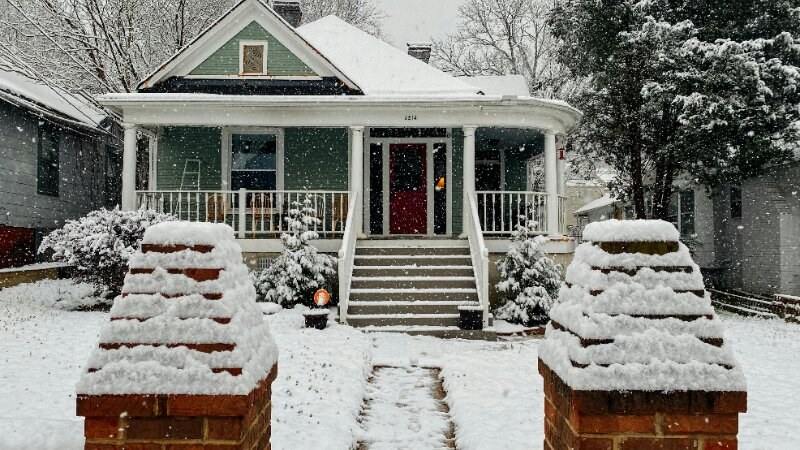Top 5 Lawn Care Tips for Overwintering Your Lawn
Reading time: 7 minutesThe extreme winter conditions that Western Canada experiences can spell trouble for lawns that don’t get the proper care and advance preparation needed to help them survive the brutal weather. There may not be much to do when the ground is frozen hard, but these easy tips can help you protect your grass over the winter and prepare it for a lush green return.

Understanding How Your Lawn Changes in the Winter
Understanding your lawn’s needs shift from season to season is the first critical component to creating a beautiful lawn year-round. When the weather gets chilly, grass begins to go dormant. This happens sooner with warm-season grasses than cool-season grasses, but eventually, even cold-resistant lawns will lose their green colour and start to look brown or dried out despite getting plenty of moisture.
It may look unnerving, but it’s a normal survival mechanism for grass to conserve more water and energy. Even if your grass looks dead, it’s probably not. If you’ve done good fall lawn care when temps rise in the spring, and your lawn gets more sunlight, your grass can “shake it off,” and its colour will return.
5 Tips to Overwinter Your Lawn in Western Canada
While winter lawn care in Western Canada is almost exclusively done during the fall before the ground freezes, there are a few things you can (and should) do over the winter to protect your grass and ensure it has a vibrant arrival when the weather starts to warm in late March and early April. Here are our top 5 tips:
1. Make Adjustments to Your Watering Schedule
To water or not to water? That question plagues many homeowners' minds, especially in Western Canada, where winters generally mean dealing with subzero temperatures.
In a report for the Department of Atmospheric and Oceanic Sciences at McGill University in Montreal, researchers found that it takes 13 inches of snow to equal just 1 inch of water, contrary to previously established data that suggested a ratio of 10 inches of snow to 1 inch of water. That being said, watering your lawns at this time, when the ground is frozen, may actually lead to additional problems. The water may freeze on the grass blades, causing serious damage.
So, the best thing you can do for your lawn is simply watch it. Keep an eye on how much snow accumulates over the winter, and understand how that may affect your lawn come Spring when it is time to wake up.
If there has been lots of snowfall, the excess moisture should help it bounce back quickly; if not, some extra care and water in the Spring may make all the difference to having a beautiful lawn. The more you know!

2. Prevent Heavy Foot Traffic Across Your Lawn
Your lawn is putting all of its energy into survival during the arctic conditions Canada is so well known for, so it’s crucial to prevent additional stress. Don’t let kids play in the snow on your lawn, and make sure people have an alternative path to get from your house to the driveway and street.
While grass is pretty resilient, this is mostly the case in summer when your lawn has plenty of water and nutrients to spare. Soil is most vulnerable to becoming compacted in the winter under heavy snow and ice cover, so you don’t want to add to this with any extra traffic.
3. Be Careful When Using Ice Melt
Ice melt products may be a convenient way to prevent ice buildup and de-ice walkways, driveways, and other areas around your home, but they also pose a significant risk to the health of your lawn.
These compounds are generally made of strong salts that lower the temperature at which water molecules freeze, making it less likely for ice to accumulate in the areas where the salt was applied. However, if the salt comes into contact with your lawn, it can cause severe damage and dieback. If you want to use ice melt, turn to professionals or look for products marketed as safer for the local ecosystem.
4. Watch for Signs of Damage
It’s also crucial that you don’t forget about your lawn in the winter or assume it doesn’t need any care while dormant. This time of year is one of the most problematic for grass in Western Canada, and an important part of overwintering is catching problems and addressing them as early as possible. Some things to keep an eye out for include:
- Snow mold. Long periods of snow cover are common here, which creates the perfect environment for snow mould to spread across your lawn. The damage tends to be the worst in areas where snow is thicker, like drifts that have accumulated or snow that has been plowed into piles.
- Desiccation. Also called “winter kill,” desiccation occurs when your lawn is exposed to dry, cold wind and extreme temperatures from snow and ice. When this happens, your lawn is at significant risk of moisture loss, and it’s important to take preventative action ahead of time. You can do this by watering your lawn during the day when temperatures are over 5 degrees Celsius and no rain or snow is forecasted for the next few days.
- Patch disease. If there’s been a lot of snow cover, monitor for lawn diseases whenever the snow melts, and you can see your grass peeking through. If necessary, you can apply a fungicide if you haven’t already taken this step during your fall lawn care.
5. Prepare for Spring
As outdoor temperatures increase, your lawn’s needs change again and the demand for water and nutrients increases. Transitioning from winter lawn care to spring is an important time for your grass, and what you do as your lawn’s dormancy lifts can set the stage for health and vibrancy through the summer and even into early fall.
When the snow melts, and there isn’t any in the immediate forecast, it’s a good idea to start raking. Contrary to popular belief, raking leaves isn’t just a fall activity. Take your rake and break up grass clumps that have been matted down by snow. This allows more air and sunlight to reach vital parts of your lawn and stimulates new grass growth just as the weather is ready to sustain it.

FAQ
When should I put a winterizer on my lawn?
Since there's very little you can do to provide your lawn with nutrition during Canada's glacial winters, fertilizing your grass before the cold season becomes even more critical. Applying winterizer should be done in the fall, well before the ground freezes. If you fertilize too close to the frost threshold, you risk growing new grass that will inevitably become damaged by ice soon after.
Check your local frost dates and your soil's temperature to ensure you're fertilizing before the weather dips below 10 degrees Celsius. Ideally, a winterizer should be applied a few weeks before the expected first freeze in your area. If you've missed this window, you must wait until spring before fertilizing again.
Should I cover my grass in the winter?
Covering cold-sensitive plants during the winter can be helpful, but the same isn’t necessarily true for your lawn. Covering your grass with a tarp or plastic prevents light and oxygen from getting to your lawn, and if snow accumulates on top of it, the situation can worsen and cause your grass to suffocate and die completely.
Do I have to worry about lawn pests during the winter?
It's a common misconception that Canada's winters are frigid enough to cease all pest activity. While some insects proliferate much less during the cold season, others take to tall grass and brush piles in the winter. Removing debris accumulation and dethatching your lawn in the fall is necessary for winter pest prevention. Well-maintained grass is more resistant to pests and nuisance animal infestations.
Are You Preparing Your Lawn for Winter? Green Drop Can Help
At Green Drop, we have the experience, skills, and tools to help you prepare your lawn for winter and encourage vigorous spring growth. Our team of lawn care experts is available now to answer your important questions.

